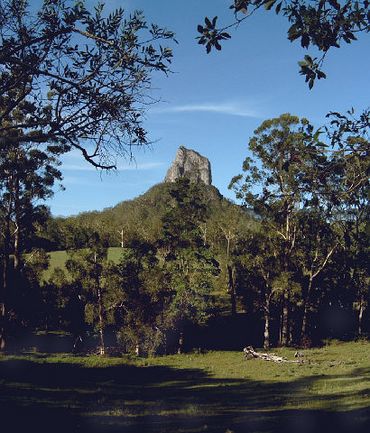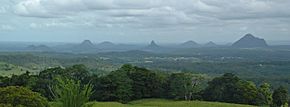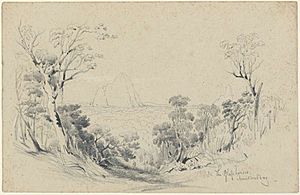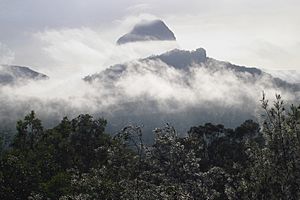Glass House Mountains National Park facts for kids
Quick facts for kids Glass House Mountains National ParkQueensland |
|
|---|---|
|
IUCN Category II (National Park)
|
|

|
|
| Nearest town or city | Brisbane |
| Established | 1994 |
| Managing authorities | Queensland Parks and Wildlife Service |
| Website | Glass House Mountains National Park |
| See also | Protected areas of Queensland |
| Glass House Mountains National Park | |
|---|---|
| Lua error in Module:Location_map at line 420: attempt to index field 'wikibase' (a nil value). | |
| Location | Glass House Mountains, Sunshine Coast Region, Queensland, Australia |
| Official name: Glass House Mountains National Park and Beerburrum Forest Reserve 1 | |
| Type | state heritage (landscape) |
| Designated | 3 May 2007 |
| Reference no. | 602494 |
| Significant period | early Tertiary Period - present |
The Glass House Mountains National Park is a special protected area in Queensland, Australia. It's about 70 kilometers (43 miles) north of Brisbane. This park is famous for its unique mountains. These mountains are actually the hard cores of ancient, extinct volcanoes. They formed about 26 to 27 million years ago! Over time, softer rocks around them wore away, leaving these amazing peaks standing tall.
The national park was created in 1994. In 2010, the park grew even bigger, adding more land to protect these natural wonders. The Glass House Mountains are also listed on the Queensland Heritage Register, which means they are important for their history and natural beauty.
Contents
Visiting the Glass House Mountains
You can find places to camp at Glass House Mountains township and Coochin Creek. These are great spots to stay if you want to explore the area. There are also lookouts at the top of some mountains, offering amazing views.
You can enjoy walking tracks to climb Mount Beerwah, Mount Tibrogargan, and Mount Ngungun. To get to the park, you can take the Steve Irwin Way exit from the Bruce Highway.
History of the Mountains
The Glass House Mountains are a very important landmark in southeast Queensland. They are tall, steep-sided peaks made of tough rocks like trachyte and rhyolite. These rocks were once inside active volcanoes millions of years ago. Wind and water have worn away the softer parts of the volcanoes, leaving only these strong cores. Now, they rise dramatically from the flat land around them.
The mountains are very special to Indigenous people of the region. They are central to their creation stories and still hold great spiritual meaning today.
European Discovery
The first European to describe the Glass House Mountains was Lieutenant James Cook. He sailed along the Australian coast in 1770 on his ship, the HM Bark Endeavour. The mountains reminded him of the large glass furnaces, called "glasshouses," back in his home of Yorkshire. So, he named them the Glass Houses.
In 1799, Lieutenant Matthew Flinders also sailed past the coast. He explored the area and even tried to climb Mount Tibrogargan with two sailors and an Aboriginal man named Bungaree. They managed to climb Mount Beerburrum.
Over the years, other explorers like John Oxley, Allan Cunningham, Andrew Petrie, and Ludwig Leichhardt visited and studied the mountains. In 1848, Andrew and John Petrie even climbed Mount Beerwah and left a note at the top!
Mountains in Art and Culture
The Glass House Mountains have inspired many artists. For example, Conrad Martens painted them in his work Glasshouse Mountains, Moreton Bay. Many poems and stories, like The Mountains Played by Judith Wright, have been written about them.
They have also been a popular subject for photographers for a very long time. Even today, musicians like Robert Davidson and John Gilfedder create works inspired by these amazing mountains.
Because they are close to big cities, the mountains are popular for tourists. People love to go bushwalking, climbing, and enjoy the beautiful views from the peaks.
Protecting Nature
The Glass House Mountains are like natural islands for plants and animals. They protect special areas of mountain plants, including 26 types that are rare or endangered. The different parts of the mountains, like rocky slopes and gullies, offer many homes for plants. These range from open forests to heathlands and shrublands. The mountains also provide a home for many rare or endangered animals.
The area we now call Glass House Mountains National Park was first protected in 1954. Smaller parks like Beerwah and Tibrogargan were combined to form the larger national park in 1994.
About the Mountains
The Glass House Mountains are a group of unique hills and peaks that stand out sharply from the flat land. They are the remains of ancient volcanic plugs. They are located about 65 to 75 kilometers (40 to 47 miles) north of Brisbane.
The Glass House Mountains National Park includes eleven of the 16 Glass House Mountains. It also has a small area called Blue Gum Creek. The park is divided into eight sections, covering about 883 hectares (2,182 acres) in total.
- Mount Tibrogargan (364 meters / 1,194 feet) and Mount Cooee (106 meters / 348 feet) are made of alkali rhyolite rock. Mount Cooee has caves and is a home for the peregrine falcon. Mount Tibrogargan is the third highest peak and is open for climbing.
- Mount Beerwah (556 meters / 1,824 feet) is the highest peak in the park. It's made of alkali trachyte. Near the top, you can see large hexagonal rock columns, sometimes called the "Organ Pipes." This mountain also has caves and is a home for the peregrine falcon. Public access to the main climbing track has been limited since 2009.
- Mount Ngungun (253 meters / 830 feet) is made of alkali rhyolite. It also has cool vertical rock columns and caves. There's also evidence of old quarrying from the 1950s.
- Mount Coonowrin (377 meters / 1,237 feet), also known as Crookneck, is the second highest mountain. It's made of alkali rhyolite and has vertical rock columns and caves. It's also a home for the peregrine falcon. However, climbing this mountain has been stopped since 1999 because of safety concerns with the rocks.
- Mount Elimbah (109 meters / 358 feet) is often called Saddleback because of its shape. It's made of alkali rhyolite. You can find old trenches on its lower slopes that were used for World War Two army training.
- Blue Gum Creek is a small area of about 11 hectares (27 acres). It protects populations of the endangered swamp stringybark tree. It's also a home for several rare frog species, including the wallum froglet, wallum sedge frog, Freycinet's frog, and the rare green thighed frog.
- Mount Miketeebumulgrai (202 meters / 663 feet) is made of porphyritic trachyte. It provides feeding and nesting spots for the black cockatoo and the rare grey goshawk.
- Mount Coochin (west hill 235 meters / 771 feet, east hill 230 meters / 755 feet), also known as Coochin Hills, is made of alkali rhyolite. It supports an area of the endangered plant species Leucopogon recurvisepalus.
- Mount Beerburrum (278 meters / 912 feet) is made of porphyritic trachyte. It has complex rainforest and some endangered plant species like Tindal's stringybark and Pink bloodwood. There's a forestry fire tower with a viewing platform at the top.
- Mount Tunbubudla (west twin 294 meters / 965 feet, east twin 338 meters / 1,109 feet), also called the Twins, is made of alkali rhyolite. Most of this mountain is covered in dry forest. It also has areas of exposed rock where you can find the rare Bronze-barked Tea Tree, a plant found only in the Glass House Mountains.
- Mount Tibberoowuccum (220 meters / 722 feet) is a dome-shaped rock surrounded by open forest and some rainforest. It has a small population of the Narrow-leaf bitter-pea, a shrub that is rare in Queensland.
Flora and Fauna

The peaks of the Glass House Mountains have many different types of habitats for plants and animals. These include mountain heathlands, shrublands, open forests, woodlands, and small rainforest patches. The mountain heathlands are especially rich in rare and unique plant species, many of which can't be found anywhere else. In total, there are 26 rare plant species on these heathlands.
One special plant is the Glasshouse Mountains Tea Tree, which is only found on these peaks. It's known for its beautiful smooth orange bark. Another unique plant is the Mount Beerwah Mallee Red Gum, named after the local Aboriginal tribe, the Kabi Kabi. Other plants found only here include Gonocarpus effusus, Grevillea hodgei, Westringia grandifolia, and Leptospermum oreophyllum.
Why the Park is Important
The Glass House Mountains National Park and Beerburrum Forest Reserve 1 were added to the Queensland Heritage Register in 2007 for several reasons:
- Showing History: These ancient mountains show how the landscape has changed over millions of years due to volcanic activity. Because they are so big and easy to spot, they helped early European explorers navigate the coast. Captain Cook named them in 1770, and Matthew Flinders also explored the area. Other important explorers like John Oxley and Andrew Petrie also visited.
- Beautiful Scenery: The Glass House Mountains are visually stunning. They rise dramatically from the flat land and can be seen from far away. The views of the mountains, and the views from the mountains, are incredibly beautiful. They have inspired countless paintings and photographs. Their majestic beauty continues to attract many visitors to the national park.
- Cultural Importance: The Glass House peaks are very important to Indigenous people and are central to their creation stories. They hold deep cultural meaning.
The wider community also loves the mountains as places to visit and enjoy. Because they are close to Brisbane and other major towns, they are easy for day-trippers to reach. For many years, people have enjoyed bushwalking, picnicking, and seeing the amazing volcanic scenery here.
See also
 In Spanish: Parque nacional Montaña Glasshouses para niños
In Spanish: Parque nacional Montaña Glasshouses para niños




